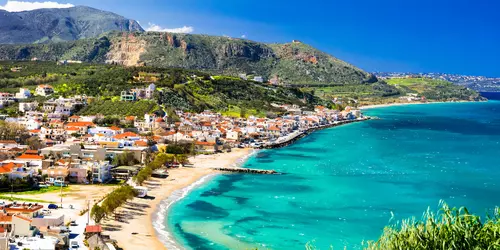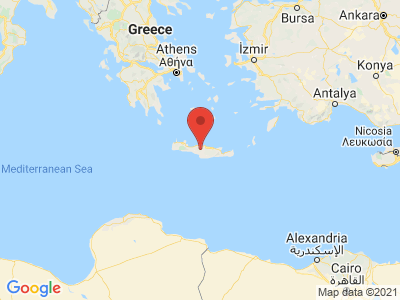Climate Table Crete
Jan | Feb | Mar | Apr | May | Jun | Jul | Aug | Sep | Oct | Nov | Dec | |
|---|---|---|---|---|---|---|---|---|---|---|---|---|
| Max. Temperature | 16° | 16° | 17° | 20° | 24° | 28° | 29° | 29° | 28° | 27° | 21° | 17° |
| Min. Temperature | 9° | 9° | 10° | 12° | 15° | 19° | 21° | 22° | 19° | 16° | 14° | 11° |
| Sun Hours | 3 | 5 | 6 | 8 | 10 | 12 | 13 | 12 | 10 | 6 | 6 | 4 |
| Water Temperature | 16° | 15° | 16° | 16° | 19° | 22° | 24° | 25° | 24° | 23° | 20° | 17° |
| Rain Days | 12 | 7 | 8 | 4 | 2 | 1 | 0 | 0 | 2 | 6 | 6 | 10 |
The climate year of Crete
The largest island of Greece has an extension of over 260 kilometers from east to west and is up to 60 kilometers wide in the north-south axis, with its smallest extension in this direction being 12 kilometers. The island, which is very mountainous, has a number of very fertile plateaus, the Messara plain in the south of the island being the largest of them, covering about 140 square kilometers. In addition, the island owes a number of deep gorges to its mountainous structure. The most famous of them is the Samaria Gorge. Not far from Crete runs the so-called Greek Arc, a tectonic rift about 100 kilometers long. Where the African plate slides under the European plate, earthquakes can occur, but so far they have hardly caused any significant damage.
General information about Crete
Not only the beaches at the more than 1000 kilometers long coastline make Crete attractive for visitors, also numerous cultural-historical testimonies of ancient cultures inspire the guests. With the so-called Minoan culture, the first advanced civilization on European soil originated here 3000 years before Christ. Later the Greeks settled here. Among the historical sites worth seeing are Minoan country houses, Minoan temples, summer palaces, and port cities. Nature tourists can experience the waters of Lake Kournas and the plateaus of Anopolis, Askifou, Gious and Lasithi. On the Mediterranean Sea, the palm beaches of Preveli, Vai and Triopetra invite to a bathing vacation. Tourism is the largest source of income on the island, followed by wine, olive and fruit growing. In the West, especially the film "Alexis Zorba" made in the 1960s, has shaped the general image about the island. The story of an archaic adventurer who defies the conventions of modern civilization has encouraged many people, especially in Western Europe, to seek a life in Greece outside the consumer and performance pressures of modern society.
Tourism Crete
The average temperatures in Crete vary in their peaks between 15 degrees in January and 29 degrees in the summer months of July and August. The lows are 9 degrees in January, 11 degrees in December and 22 degrees in the high season. While it can rain more frequently from January to March (January, for example, counts an average of 14 rainy days), from June to October there is a maximum of 11 rainy days on average, of which five rainy days fall on October alone. The average sunshine duration is over eight hours from April onwards, and only drops to six hours in October. Statistically, visitors can experience the longest sunshine duration in July. In this month, the sun shines for 13 hours a day.


